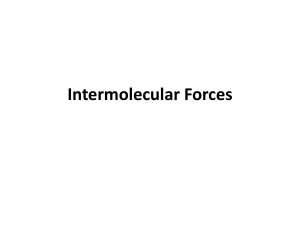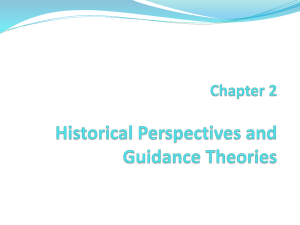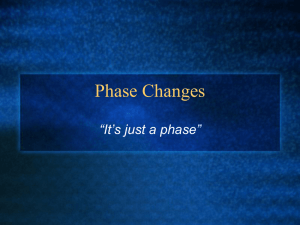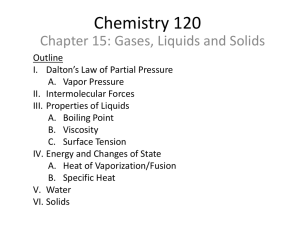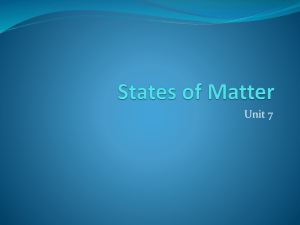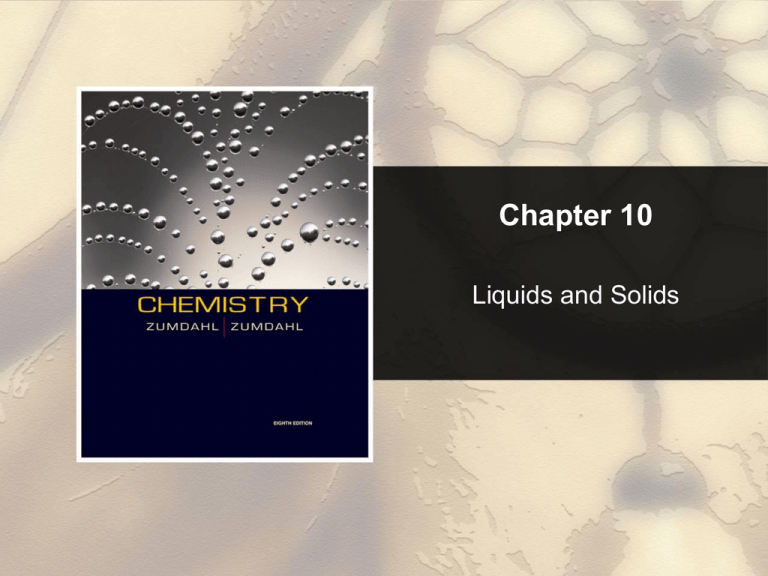
Chapter 10
Liquids and Solids
Chapter 10
Table of Contents
10.1
10.2
10.3
10.5
10.8
10.9
Intermolecular Forces
The Liquid State
An Introduction to Structures and Types of Solids
Carbon: Network Atomic Solids
Vapor Pressure and Changes of State
Phase Diagrams (no longer on AP, but still included)
Copyright © Cengage Learning. All rights reserved
2
Section 10.1
Intermolecular Forces
Intramolecular Bonding
• “Within” the molecule.
• Molecules are formed by sharing electrons
between the atoms.
Return to TOC
Copyright © Cengage Learning. All rights reserved
3
Section 10.1
Intermolecular Forces
Intermolecular Forces
• Forces that occur between molecules.
Dipole–dipole forces
Hydrogen bonding
London dispersion forces
• Intramolecular bonds are stronger than
intermolecular forces.
• Ion-ion is stronger than any intermolecular
force
Return to TOC
Copyright © Cengage Learning. All rights reserved
4
Section 10.1
Intermolecular Forces
Hydrogen Bonding in
Water
•
Blue dotted lines are
the intermolecular
forces between the
water molecules.
Return to TOC
Copyright © Cengage Learning. All rights reserved
5
Section 10.1
Intermolecular Forces
Phase Changes
• When a substance changes from solid to liquid
to gas, the molecules remain intact.
• The changes in state are due to changes in the
forces among molecules rather than in those
within the molecules.
Return to TOC
Copyright © Cengage Learning. All rights reserved
6
Section 10.1
Intermolecular Forces
Schematic Representations of the Three States of Matter
Return to TOC
Copyright © Cengage Learning. All rights reserved
7
Section 10.1
Intermolecular Forces
Phase Changes
• Solid to Liquid
As energy is added, the motions of the
molecules increase, and they eventually
achieve the greater movement and disorder
characteristic of a liquid.
• Liquid to Gas
As more energy is added, the gaseous state
is eventually reached, with the individual
molecules far apart and interacting relatively
little.
Return to TOC
Copyright © Cengage Learning. All rights reserved
8
Section 10.1
Intermolecular Forces
1. Hydrogen Bonding (strongest)
• The hydrogen bond is a special dipole-dipole
interaction between the hydrogen atom in a
polar N-H, O-H, or F-H bond and an
electronegative O, N, or F atom. IT IS NOT A
BOND.
Return to TOC
Copyright © Cengage Learning. All rights reserved
9
Section 10.1
Intermolecular Forces
Hydrogen Bonding
Return to TOC
Copyright © Cengage Learning. All rights reserved
10
Water is a Unique Substance
Maximum Density
40C
Density of Water
Ice is less dense than water
11.3
Types of Intermolecular Forces
2. Ion-Dipole Forces
Attractive forces between an ion and a polar molecule
Ion-Dipole Interaction
11.2
11.2
Section 10.1
Intermolecular Forces
3. Dipole-Dipole Forces
• Dipole moment – molecules with polar bonds
can attract each other electrostatically. They
line up so that the positive and negative ends
are close to each other.
• Only about 1% as strong as covalent or ionic
bonds.
Return to TOC
Copyright © Cengage Learning. All rights reserved
14
Section 10.1
Intermolecular Forces
Dipole-Dipole Forces
Return to TOC
Copyright © Cengage Learning. All rights reserved
15
Section 10.1
Intermolecular Forces
4. London Dispersion Forces (weakest)
• Instantaneous dipole that occurs accidentally in
a given atom induces a similar dipole in a
neighboring atom.
• Significant in large atoms/molecules.
• Occurs in all molecules, including nonpolar
ones.
Return to TOC
Copyright © Cengage Learning. All rights reserved
16
Section 10.1
Intermolecular Forces
London Dispersion Forces
Return to TOC
Copyright © Cengage Learning. All rights reserved
17
What type(s) of intermolecular forces exist between
each of the following molecules?
HBr
HBr is a polar molecule: dipole-dipole forces. There are
also dispersion forces between HBr molecules.
CH4
CH4 is nonpolar: dispersion forces.
S
SO2
SO2 is a polar molecule: dipole-dipole forces. There are
also dispersion forces between SO2 molecules.
11.2
Section 10.1
Intermolecular Forces
Concept Check
Which molecule is capable of forming
stronger intermolecular forces?
N2
H2O
Explain.
Return to TOC
Copyright © Cengage Learning. All rights reserved
19
Section 10.1
Intermolecular Forces
Melting and Boiling Points
• In general, the stronger the intermolecular
forces, the higher the melting and boiling points.
Return to TOC
Copyright © Cengage Learning. All rights reserved
20
Section 10.1
Intermolecular Forces
The Boiling Points of the Covalent Hydrides of the Elements in
Groups 4A, 5A, 6A, and 7A
Return to TOC
Copyright © Cengage Learning. All rights reserved
21
Section 10.1
Intermolecular Forces
Concept Check
Draw two Lewis structures for the formula
C2H6O and compare the boiling points of the
two molecules.
H H
H C C O H
H H
H
H C O
H
H
C H
H
Return to TOC
Copyright © Cengage Learning. All rights reserved
22
Section 10.2
Atomic
The
Liquid
Masses
State
Liquids
• Low compressibility, lack of rigidity,
and high density compared with
gases.
• Surface tension – resistance of a
liquid to an increase in its surface
area:
Liquids with large intermolecular
forces tend to have high surface
tensions.
Return to TOC
Copyright © Cengage Learning. All rights reserved
23
Section 10.2
Atomic
The
Liquid
Masses
State
Liquids
• Capillary action – spontaneous rising of a liquid
in a narrow tube:
Cohesive forces – intermolecular forces
among the molecules of the liquid.
Adhesive forces – forces between the liquid
molecules and their container.
Return to TOC
Copyright © Cengage Learning. All rights reserved
24
Section 10.2
Atomic
The
Liquid
Masses
State
Convex Meniscus Formed by Nonpolar Liquid Mercury
Which force dominates alongside the glass tube
– cohesive or adhesive forces?
cohesive forces
Return to TOC
Copyright © Cengage Learning. All rights reserved
25
Properties of Liquids
Cohesion is the intermolecular attraction between like molecules
Adhesion is an attraction between unlike molecules
Adhesion
attracted to glass
Cohesion
attracted to each other
11.3
Section 10.2
Atomic
The
Liquid
Masses
State
Liquids
• Viscosity – measure of a liquid’s resistance to
flow:
Liquids with large intermolecular forces or
molecular complexity tend to be highly
viscous.
Return to TOC
Copyright © Cengage Learning. All rights reserved
27
A crystalline solid possesses rigid and long-range order. In a
crystalline solid, atoms, molecules or ions occupy specific
(predictable) positions.
An amorphous solid does not possess a well-defined
arrangement and long-range molecular order.
A unit cell is the basic repeating structural unit of a crystalline
solid.
At lattice points:
lattice
point
Unit Cell
Unit cells in 3 dimensions
•
Atoms
•
Molecules
•
Ions
11.4
11.4
Section 10.3
TheIntroduction
An
Mole
to Structures and Types of Solids
Types of Crystalline Solids
• Ionic Solids – ions at the points of the lattice
that describes the structure of the solid. Ion-ion
is strong than all IM forces
• Atomic Solids – atoms at the lattice points that
describe the structure of the solid. Stronger
than IM forces but generally weaker than ionion
• Molecular Solids – discrete covalently bonded
molecules at each of its lattice points. Held
together with only IM forces
Return to TOC
Copyright © Cengage Learning. All rights reserved
30
Section 10.3
TheIntroduction
An
Mole
to Structures and Types of Solids
Examples of Three Types of Crystalline Solids
Return to TOC
Copyright © Cengage Learning. All rights reserved
31
Section 10.5
Carbon and Silicon: Network Atomic Solids
Network Solids
Return to TOC
Copyright © Cengage Learning. All rights reserved
32
Section 10.5
Carbon and Silicon: Network Atomic Solids
The Structures of Diamond and Graphite
Return to TOC
Copyright © Cengage Learning. All rights reserved
33
Types of Crystals
Metallic Crystals – Typically weaker than covalent, but can be
in the low end of covalent
•
•
•
•
Lattice points occupied by metal atoms
Held together by metallic bonds
Soft to hard, low to high melting point
Good conductors of heat and electricity
Cross Section of a Metallic Crystal
nucleus &
inner shell emobile “sea”
of e-
11.6
Section 10.8
Vapor Pressure and Changes of State
Vapor Pressure
• Pressure of the vapor present at equilibrium.
• The system is at equilibrium when no net
change occurs in the amount of liquid or vapor
because the two opposite processes exactly
balance each other.
Return to TOC
Copyright © Cengage Learning. All rights reserved
35
Section 10.8
Vapor Pressure and Changes of State
The Rates of Condensation and Evaporation
Return to TOC
Copyright © Cengage Learning. All rights reserved
36
Section 10.8
Vapor Pressure and Changes of State
Concept Check
What is the vapor pressure of water at
100°C? How do you know?
1 atm
Return to TOC
Copyright © Cengage Learning. All rights reserved
37
Section 10.8
Vapor Pressure and Changes of State
Vapor Pressure
Return to TOC
Copyright © Cengage Learning. All rights reserved
38
Section 10.8
Vapor Pressure and Changes of State
Vapor Pressure
• Liquids in which the intermolecular forces are
strong have relatively low vapor pressures.
• Vapor pressure increases significantly with
temperature.
Return to TOC
Copyright © Cengage Learning. All rights reserved
39
Section 10.8
Vapor Pressure and Changes of State
Vapor Pressure vs.
Temperature
Return to TOC
Copyright © Cengage Learning. All rights reserved
40
Section 10.8
Vapor Pressure and Changes of State
Changes of State
Return to TOC
Copyright © Cengage Learning. All rights reserved
41
Section 10.8
Vapor Pressure and Changes of State
Heating Curve for Water
Return to TOC
Copyright © Cengage Learning. All rights reserved
42
Section 10.9
Phase Diagrams
• A convenient way of representing the phases of
a substance as a function of temperature and
pressure: (not on AP, but on my test!)
Triple point
Critical point
critical temperature (Tc) - temperature above
which the gas cannot be made to liquefy, no
matter how great the applied pressure.
critical pressure (Pc) - minimum pressure that
must be applied to bring about liquefaction at the
critical temperature.
Phase equilibrium lines
Return to TOC
Copyright © Cengage Learning. All rights reserved
43
Section 10.9
Phase Diagrams
Phase Diagram for
Carbon Dioxide
Return to TOC
Copyright © Cengage Learning. All rights reserved
44
Section 10.9
Phase Diagrams
Phase Diagram for
Water
Return to TOC
Copyright © Cengage Learning. All rights reserved
45
Where’s Waldo?
Can you find…
The Triple Point?
Critical pressure?
Critical
temperature?
Where fusion
(s -> l) occurs?
Where vaporization
(l -> g) occurs?
Melting point
(at 1 atm)?
Carbon Dioxide
Boiling point
(at 6 atm)?
Section 10.9
Phase Diagrams
Concept Check
As intermolecular forces increase, what happens to
each of the following? Why?
Boiling point
Viscosity
Surface tension
Enthalpy of fusion (solid to liquid)
Freezing point
Vapor pressure
Heat of vaporization (liquid to gas)
Return to TOC
Copyright © Cengage Learning. All rights reserved
48

